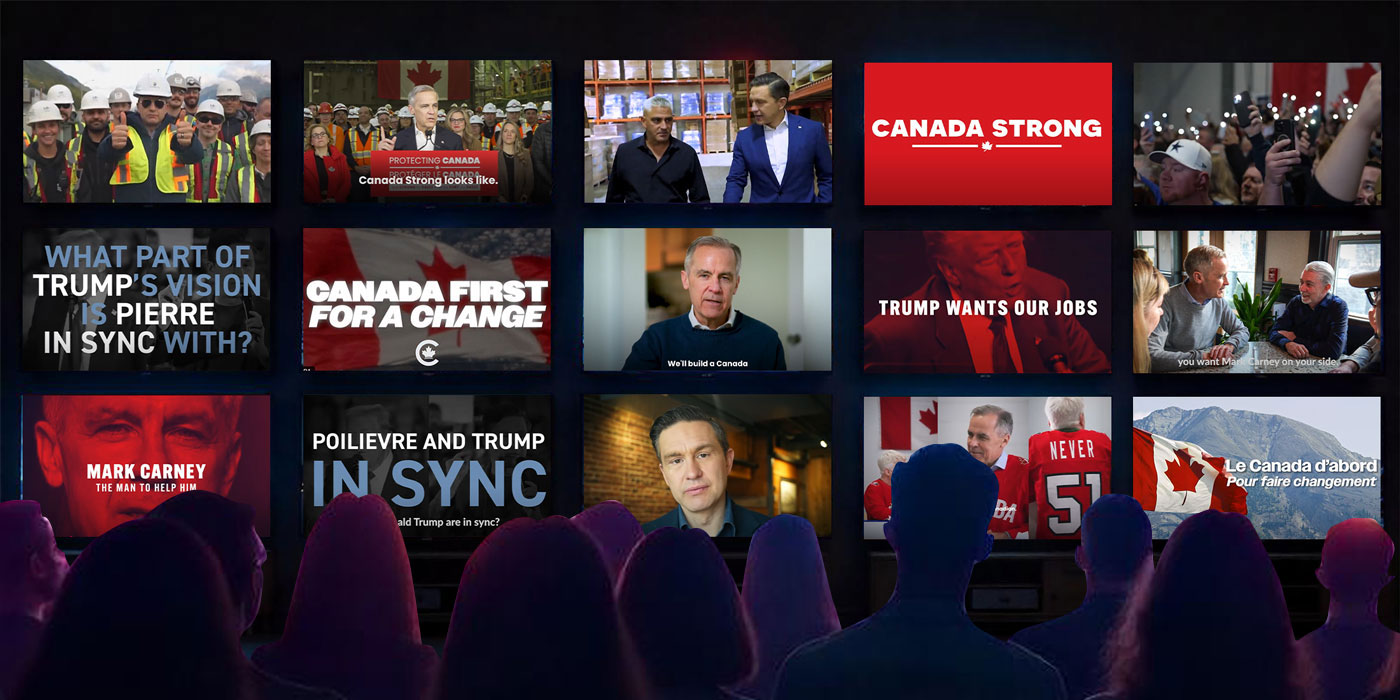Tories’ creative daily ad content bests Grits’ sophisticated distribution strategy, says digital marketing critic

With political advertising from the federal parties and their candidates blanketing Canadians’ social media, streaming platforms, TVs, and radios, online political marketing strategist Harneet Singh says the Liberals have impressed with an optimized and sophisticated distribution strategy and the requisite budget to back it up. Yet, while the Conservatives’ ad spending shrank in the first two weeks of the campaign, Canadians are still tuning in for their top-notch creativity, and diverse and economical daily content, he said.
“I’m impressed by the Liberals’ strategy. They’ve launched a ton of ads with tons of variations,” explained Singh, a managing principal at EOK Consults, noting that both the Liberals and Conservatives are using the artificial intelligence-generated A/B testing provided by Meta’s ad service, which varies the ad-copy based on the viewers location, demographic information, and interests.
“The Liberals have an impressive, sophisticated distribution strategy, but honestly, the Conservatives’ creativity is top notch,” Singh said. “The Liberals are winning in distribution and spending, but the Conservatives’ ads are authentic, inspiring, and cinematic.”
As of April 4, the five main parties—including the NDP, Bloc Québécois, and Green Party—have spent a combined $2.4-million on Facebook and Instagram advertising, according to Meta’s Ad Library, with the Liberals in the lead with $1.3-million spent since March 23, followed by the Conservatives with $1.04-million. The remaining three parties have totals in the $19,000-25,000 range.
However, Singh noted that the campaigns have been using Meta platforms—as well as X and their respective YouTube channels—as testing grounds, and transferring what works best to run ads elsewhere online, as well as on platforms offered by Bell or Rogers Media for television and radio spots.

Singh said many of his favourite ads the parties have produced and posted online are the same ones they have transferred to television and radio, including the Liberals’ introductory Who is Mark Carney ad, and the more recent affordable housing spot from March 31.
However, while the Liberals’ ads get full marks for professionalism and production value, those more traditional ready-for-TV spots have less impact than the varied and innovative content the Conservatives create daily, strategists say.
Within that steady stream of political messaging and digital content from the Conservatives, Singh noted at least four distinct categories, including the more traditional spots; longer-form “mini-docs” like Carney in the coal mine; or the “daily appeals” highlighting the previous days’ talking points and announcements on things like John A. Macdonald, the Ring of Fire, cutting income taxes or the Tax Free Savings Account top-up.
The final category is the more “gonzo-style” quick-hits, featuring a single camera following Conservative Leader Pierre Poilievre as he door-knocks or speaks with stakeholders at a campaign stop. While those may not seem like traditional paid advertising content, Singh told The Hill Times he has seen both those and the video of rally-goers singing O Canada with their phones held aloft placed as paid online ads.

Hunter Knifton, a consultant and data scientist with Crestview Strategy, said that while the Conservatives are far outperforming the Liberals in terms of variation and output, the kind of content gaining the most traction was unsurprising.
“All of the top Conservative ads are the ones going at [Prime Minister Mark] Carney to attack him,” Knifton explained, noting that the most-viewed videos on both the Conservatives’ Meta Ad Library and YouTube channel were those taking direct aim at the Liberal leader, his party, or his predecessor, Justin Trudeau.
Sorted by impressions, two of the most popular ads on the Conservatives’ page include a Punjabi-language version of the If Carney Wins, Canada Loses ad, and a more recent ad placed on April 5 attacking Liberals for rising antisemitism and funding the United Nations Relief and Works Agency for Palestinian Refugees in the Near East, more commonly known as UNRWA.
Alternatively, Knifton said the Liberals’ most popular ads have been the positive, policy-focused spots, including the modular housing ad featuring Carney speaking directly into a camera at a kitchen table.
“I think that difference in tone and what’s working for the campaigns can probably explain a lot of the recent shifts in polling,” said Knifton, who served as data director and deputy director of communications for now-Housing Minister Nathaniel Erskine-Smith’s 2023 Ontario Liberal Party leadership campaign. “I think Canadians right now are looking for positive messaging, positive campaigning, and positive representation of Canada.”
While Carney’s campaign has been leaning towards that positivity because digital metrics and polling have rewarded that kind of content and messaging, the Conservatives may be misreading the public sentiment based on the feedback from their pre-existing audience, Knifton said.
Former Conservative PMO staffer Jordan Paquet said that while the Conservatives will always have a knack for the aggressive and critical, it would be a mistake to discount the effectiveness and reception of the more detailed, longer-form videos.

Paquet, now a vice-president with Bluesky Strategy Group, said the perceived wisdom in political advertising is that short, 15-to-30-second clips are the best way to capture voters’ attention, and get a message out. However, Poilievre has been priming those voters for longer-form content, Paquet said, pointing to the previous Housing Hell and Debtonation mini-docs, among several others.
“It’s really innovative, but they’ve also laid the groundwork for it over the past two years,” Paquet said, noting the increased familiarity with the format has made voters more willing to take the extra time.
In contrast, Paquet said the Liberal ads seem “plain, straightforward,” and in most cases, “boring,” but noted he neither intends that as an insult, nor believes the campaign would take it that way.
“I think that’s how they want it,” Paquet said, noting that the rest of the campaign seems to be designed in the same fashion.
“They’re running a front-runner campaign, so they don’t want to put Carney out there too much or in an ad that’s too flashy,” Paquet explained. “They’re just trying to put his face out there and a little bit of his resumé, but not much else.”
sbenson@hilltimes.com
The Hill Times






 LICENSING
LICENSING PODCAST
PODCAST ALERTS
ALERTS













